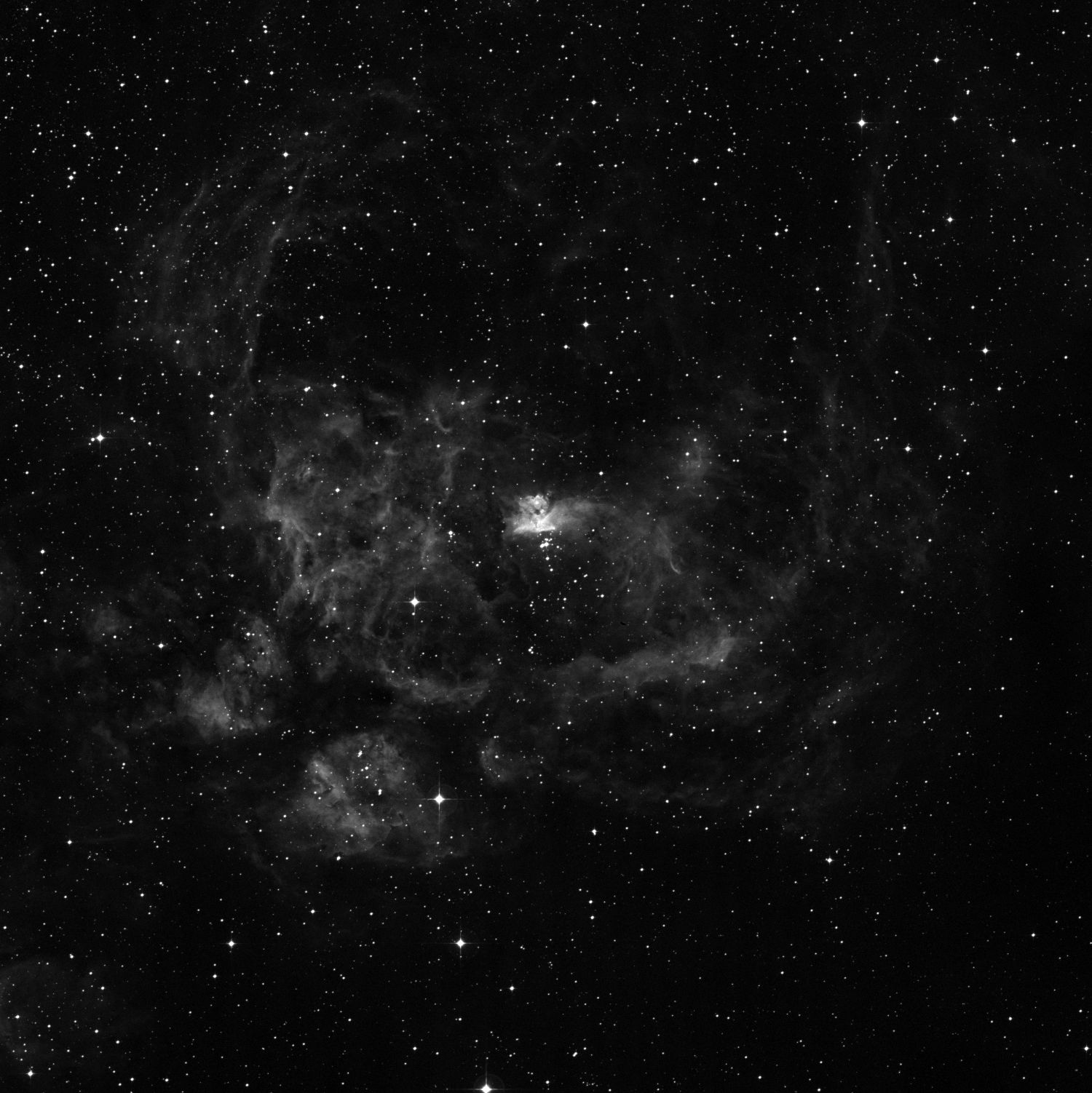From
my recent diary
2022
Unless
otherwise noted I use the following materials since the end of October,
2018.
Telescope: D: 45.5cm f: 2037mm
Dobsomian (Newtonian reflector)
Eyepiece: and magnification: Lavendura
63mm, apparent FOV 45 deg. with Paracorr
x37, actual FOV 1.2 deg.
Night Vison: ACT
PVS-14 Photonis 4G INTENS 1800 Auto gate P45 WP
Tuesday, December 27 and Wednesday, December 28
The third and the fourth comet hunting session this month.
Tuesday, December 27
I observed five comets using 46 cm with Night Vision (NV) prior to the
hunting session. The magnitude and the apparent diameter were not measured
using comparison stars, instead, determined by intuition.
C/2022 E3 ZTF mag. 8.5 dia. 2’ DC=7 tail = 0.3º
The nucleus was apparent, and the fan-shaped tail was magnificent
and worth seeing. C/2020 V2 ZTF mag. 11 dia. 1’ DC =7
C/2022 A2 PanSTARRS mag. 10 dia.1’ DC =7 Tail = 3’
C/2020 L3 ATLAS mag. 11 dia. 1.5’ DC =7
81P Wild mag.12.5 dia. 0.5’ DC = 3
I spent 8 minutes to observe those comets. After that, I enjoyed observing
NGC4564, M81, M82 and M51, and then, started the 1 hour and 40 minutes
session from α Libae. The number of the deep sky objects (DSOs) identified
during the session was 12, of those NGC5634, M107 and M5 were globular
clusters, and the others were galaxies. The two galaxies, IC998 and
IC4401, were 14th magnitude and were seen in the same FOV. Although
NGC5897, a faint globular cluster with a large apparent diameter, is
bright with the magnitude of 8.5, I overlooked this object probably
because the position was merely 8º above the horizon.

Sketch of C/2022 E3 ZTF. The tail length was 0.2º.
Wednesday, December 28
I began to the comet hunting session with α Sepentis in the vicinity
of the position where I completed the session the day before. There
appeared a lot of cloud and the sweeping was interrupted midway for 27
minutes. During the break, I drew a sketch of C/2022 E3 ZTF that was made
combining the two eyepiece, NV 37x with Ethos 21 mm + Paracorr 112x. I
could not recognize the coma structure that extends upper right from the
nucleus with NV. In total, overall structure of the tail appeared better
with Ethos 21 mm + Paracorr than with NV. In NV it was interesting the
faint and the bright parts of the tail appeared and disappeared by turning
the gain up and down. The linear shaped tail extending lower right is the
ion tail. The day before, I estimated the length as 0.3º, but it turned
out that the true value was 0.2º based on the sketch.
The number of the DSOs identified was only five, NGC5970, 5957, 6003, 6004
and 5996, due to cloud cover in the search area. I am looking forward to
brightening of C/2022 E3.
Sunday, November 27
The seventh comet hunting session was made this predawn. It was really
conformable session due to clear sky with windless condition, though air
temperature dropped from 6ºC to 5ºC.
Today’s session
I began to search with M104 and identified 36 galaxies and a comet, 81P
Wild, during 1 hour and 15 minutes using Night Vison (NV). I have
overlooked 13th magnitude diffused galaxies, NGC4773 and 4780, which was
in the same field of view with PGC158187 that has higher surface
brightness as usual. I noticed those galaxies when I identified the object
using Nexus DSC and looking at SkySafari and peered into the eyepiece
again. It is the degree of concentration and surface brightness of the
object not the magnitude itself when it comes to discovering a new comet.

PGC158187 (magnitude of 14.5), NGC4773 (13.6), 4780 (13.4). The image is 1º wide.The Digitized Sky Survey copyright © 1994
Evaluation of NV
NV, I often employed, has an advantage that one can observe some 2
magnitude fainter objects than applying usual glass eyepiece and that it
works well under the condition of light pollution and haze. Nonetheless,
the weakness of the device is that visual comet hunter cannot spot a blue
colored comet, i.e., gas-rich one, like C/2020 A2 Iwamoto, because it
looked as a star-like object. I have ever observed a blue colored comet
like C/2020 A2, C/2020 S3 Erasmus. The comet was estimated as a magnitude
of 11, apparent diameter of 2’ using NV, while the magnitude of 10 with
the diameter of 4’ by using Ethos 21 mm, 97x; the glass eyepiece was
superior to observe. However, a majority of comets are looked brighter
with NV than with a glass eyepiece.
I conducted a comparative evaluation of NV and a glass eyepiece spending 4
nights this month. Specifically, I tested the difference in comet
visibility between NV and the glass eyepiece reflecting the effect of
moonlight and lowpass filters that are applied to NV.
The evaluation was made aiming the telescope at 4 comets: C/2020 V2 ZTF,
C/2019 L3 ATLAS, 81P Wild and C/2022 E3 ZTF. The observation of C/2022 E3
ZTF was one night, but three nights were spent for the other three. C/2022
E3 was observed by interrupting the comet hunting session, while the
others were measured before the start of comet hunting sessions.
Brightness, apparent diameter and degree of concentration (DC) were
determined by intuition not using comparison stars. The analysis was made
brightness and DC only. At the time of observation, 81P was low in the sky
and estimation was darker than actual magnitude due to attenuation by the
atmosphere, but the brightness was determined without using comparative
stars. That means the values are only relative.
For the glass eyepiece Ethos 21 mm with Paracorr was used. NV was tested
without filter, and with three filters shown below.
Baader Premium 610nm Longpass
Lumicon Night Sky Hydrogen-Alpha: 640nm Longpss
Baader Premium 865nm Longpass
Regarding the moon age, three patterns were tested: age 22 (the last
quarter), 27 and moonless. In my experience, comets do not look good under
the moonlight brighter than that from the half moon.

Influence of moonlight and filters applied to NV on visibility (brightness
and DC) of comets
As shown in the table, overall, NV is advantageous for those four comets
in comparison with the glass eyepiece. There is a trend that the comets
looked brighter with greater DC using NV than with the glass eyepiece.
Additionally, the 610 nm filter works under the condition of bright
moonlight. Note that the 640 nm and the 685 nm filters are considered
effective under the light pollution. The results may reflect the four
comets are dust rich, but the trend is consistent with tens of comets that
I have ever observed.
NV is not universal when it is used as general astronomical purposes. If
observes want to enjoy color of stars, a glass eyepiece is better choice
because NV is monochrome. Under the dark sky, the glass eyepiece shows
better performance on the visibility of faint and diffused object like the
spiral structure in M33 than NV. One needs to select either NV or the
glass eyepiece depending on the situation and the purpose on the occasion.
Having said that, no one knows whether a gas-rich comet appears and one
may overlook it using NV or a dust-rich comet is approaching the earth and
the device becomes a powerful tool for the next hunting session.
Friday, October 21
Bright supernova?
Finally, the clear sky has come! I comet hunted three consecutive days and
four times in total this month.
Lovely crescent moon was at the breast of the constellation of Leo.
Shooting stars crossed the FOV belonging to the Orionids which is expected
to reach the peak on Saturday. Stars in the FOV were pinpoint thanks to
good seeing. Although it was a comfortable hunting session, unexpectedly,
I made a false discovery report on a supernova.
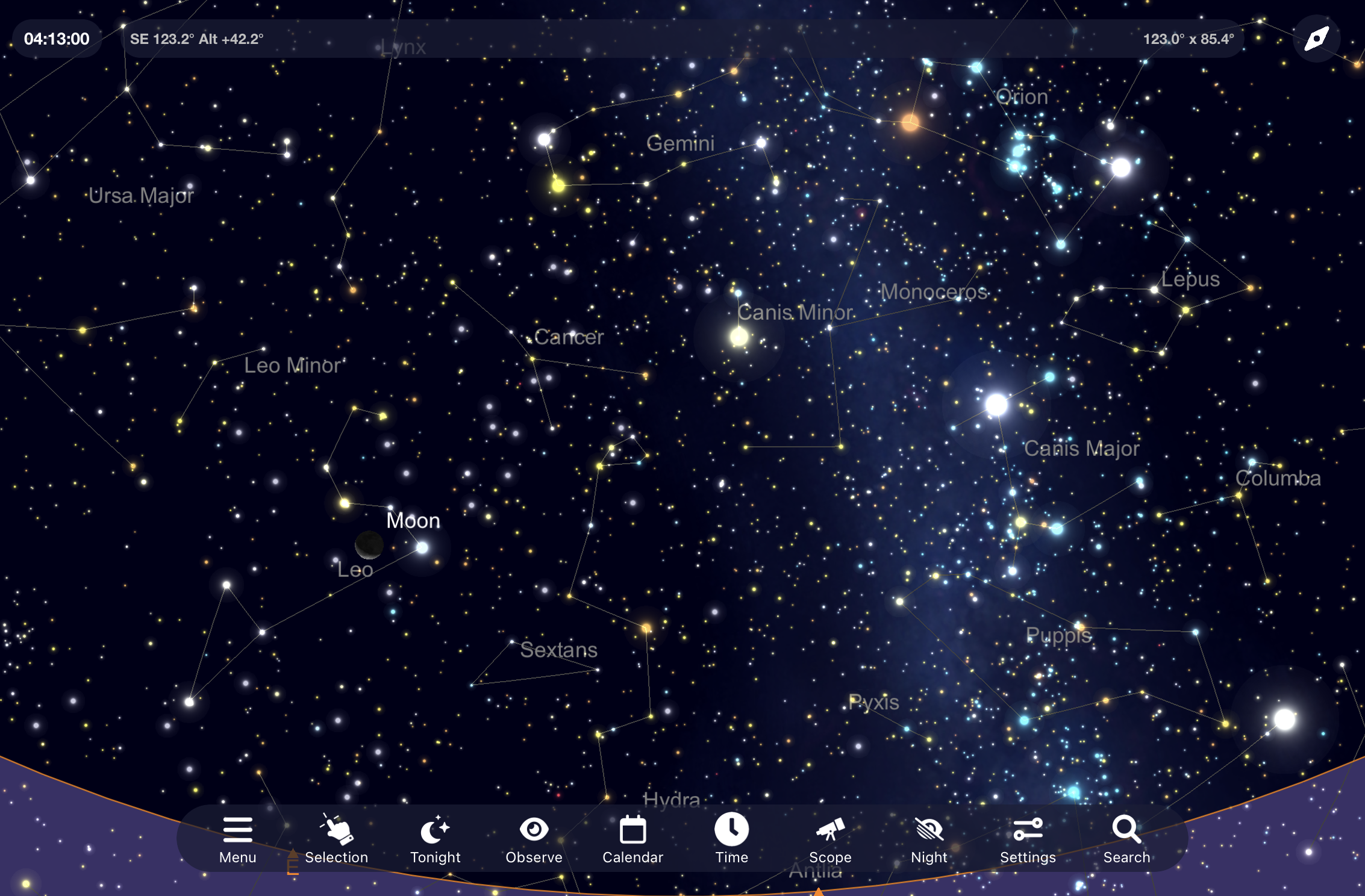 Click to
enlarge
Click to
enlarge
Eastern sky on 21 October 2022 local time. SkySafari 7 Pro.
Prior to the start of the searching session, I observed some comets.
C/2019 L3 ATLS was 11th magnitude, 3’ in apparent diameter, DC = 5 with
a tail of 0.5’ using Night Vison (NV). Using Ethos 21 mm 97x, the comet
was estimated as 12th magnitude, diameter of 1’ without a tail. C/2020
V2 ZTF had a magnitude of 10.5, diameter 1’, DC = 4, the tail length of
0.5’, while it was 11th magnitude, 1’ in diameter without a tail using
Ethos 21 mm. The periodic comet, 118P Shoemaker-Levy 4 was not seen at a
glance, and I gave up seeking it soon.
Apart from those comets, I took a short break during the hunting session,
and estimated 81P Wild 2 as 11.5 in magnitude, diameter of 1’, and DC = 5.
After a series of comet observations, I once aimed my telescope at
Procyon, and then, reduced the altitude down to the altitude of 30º where
I began to search. I identified 12 galaxies in total, e.g., NGC2865, 2781,
2811. Besides galaxies, I observed a planetary nebula, NGC3242 (Ghost of
Jupiter). The area I swept included the position of C/2019 L3, however, I
overlooked it. I detected NGC2992 and 2993 that were located 1.3º north of
the comet, and I think poor overlapping of the FOV was the cause of
overlooking.
At 5:17am local time, after 16 minutes from the beginning of the twilight,
I encountered a galaxy and a star that was close to the center of the
galaxy. I tried to confirm them using SkySafari 7 Pro. The galaxy was
NGC2974, however, the star was not indicated on the map. I saw the photo
of NGC2974 using Internet, but the image of the galaxy with the size of
some 2’ overlapped the star that made it impossible to confirm the star in
question. I estimated the brightness of the star as the magnitude of 9.0
comparing stars in the FOV. I wondered if it was a supernova, but if so,
it was too bright. I checked minor planets using Sky Safari 7 Pro, and
there was not minor planet at the position. I did not have any other
method to confirm the heavenly body of interest; I concluded that it was
an extremely bright supernova.
I could take photos of the object using iPhone X and NightCap (appli)
through NV. Both NGC2974 and the possible supernova were well
photographed.
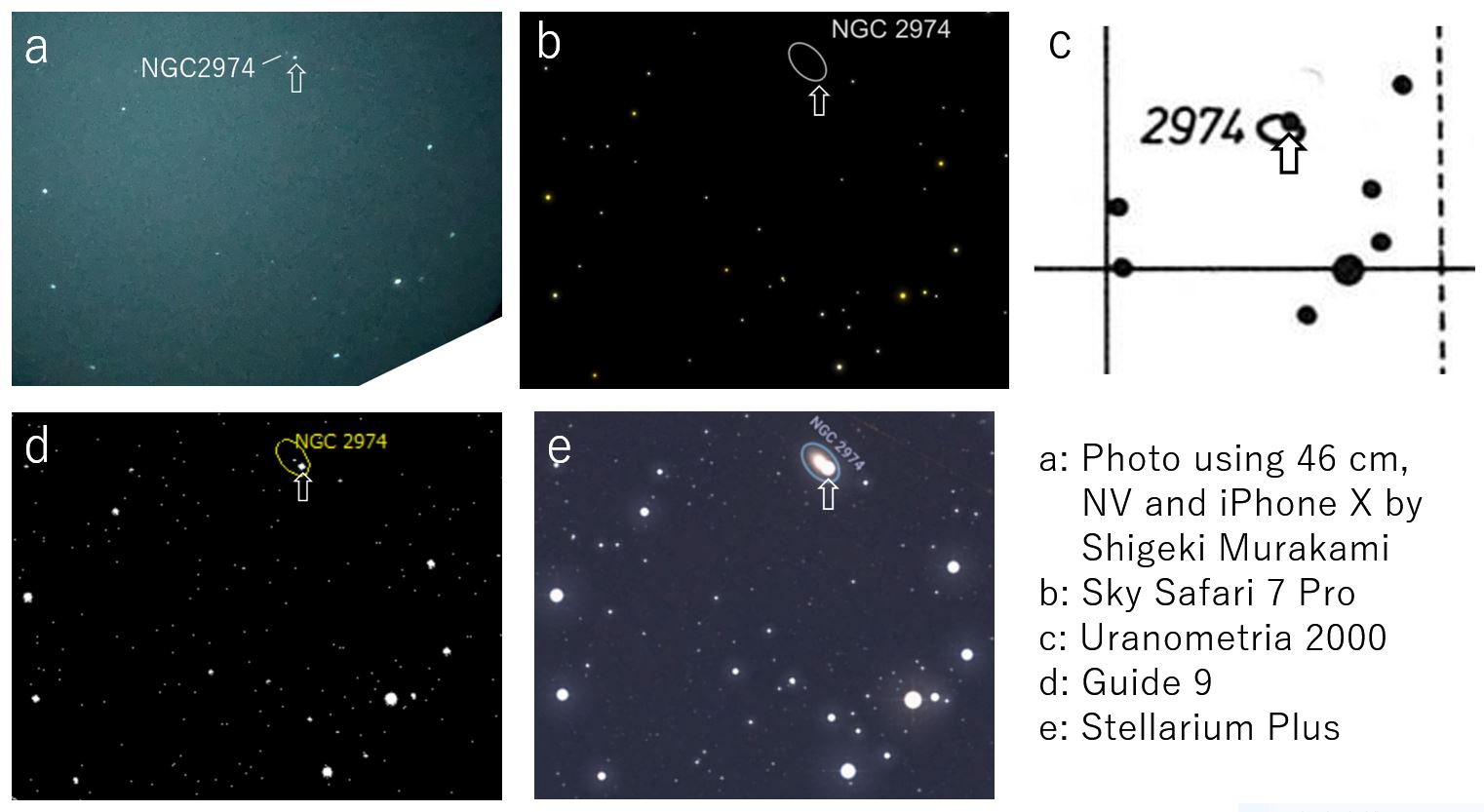 Click to enlarge
Click to enlarge
NGC2974 and possible supernova. The star in question in the photo (a) is
not drawn in SkySafari 7 Pro (b). It is in (c) Uranometria 2000, (d) Guide
9, and (e) Stellarium Plus.
Photo data: 46 cm, 37x, Night Vision PVS-14, iPhone X, 35 mm, f/1.8,
1/15sec, ISO-1000, October 21.851, 2022.
Where should I report the discovery? I knew the discovery is reported via
Internet, but do not know the specific method. In the meantime, I called
Syuichi Nakano, but no answer. Then, I made a call to National
Astronomical Observatory Japan (NAO) and left a message to the answering
machine, and got back to my house.
It is not a good idea to leave it to NAOJ. The next thing I thought was to
contact Koichi Itagaki who is world famous supernova hunter and has been
renewing the number of supernova discovery record. When I discovered 332P
Ikeya-Murakami, he received my discovery report via Nakano and confirmed
the comet just over an hour after my discovery, and I have a connection
with him. He took my call soon, and he said he confirm the object. Just
after the call, I checked the possible supernova using Guide 9 that is
installed in my PC. Surprisingly, the object was in the map! I called
Itagaki right away to tell him my wrong report, and also answering machine
of NAOJ.
I have never thought there exists such a misdescription in the digital
map. From now on, to avoid trouble like this, I decided to utilize
Stellarium Plus in addition to SkySafari 7 Pro at the site.
After a while, Itagaki called me back. He said he took photos of NGC2974
this morning for the supernova search. He usually observes hundreds of
galaxies in one night. He told me ZTF survey is raging recently as for
supernova discovery. Not only supernovae but also comets were discovered
by ZTF, however, LSST (Vera C. Rubin Observatory) conducts a powerful
survey in the near future. Though I made a false alarm, it was relief to
have a nice conversation with Itagaki and that renewed my fighting spirit.
Sunday, September 25
There has been no clear sky this month, and no prospect of fine
weather for a coming week.
While cleaning out old documents, I found a bunch of postcards from the
Japan Astronomical Circular (JAC), the astronomical news service, which I
subscribed in my junior high and high school. They were some 200 postcards
from 1976 just after I started comet searching to 1980 suspending it. The
circular was issued about once a week or so by Syuichi Nakano, Takeshi
Urata and other members that includes discoveries of new heavenly bodies
and fire ball observations and various news on astronomy. At that time
there were similar other services like Comet Bulletins issued by Tsutomu
Seki, Comet Section of the Oriental Astronomical Association (OAA). In
those days, unlike today, when the Internet is available, it was difficult
to issue and go get the latest astronomical information. I believe those
who offered the services had ardent enthusiasm, and actually, they have
been very successful after that.
In my boyhood, I was excited by the world latest astronomical news every
time I received the postcard that made my will stronger to discover a new
comet by myself.
I picked up two of the JAC as shown below. JAC No. 45 issued on 21 Feb.
1976 reported that the prediction for C/1975 V1 West becoming a great
comet and that the discovery of C/1976 D1 Bradfield. In JAC No. 54 issued
on 6 Apr.1976 there appeared a pair of sketches on the disintegrated
nucleous of C/1976 D1 by Soichi Matsui of Hida Observatory, Kyoto
University! I could not observe the comet because I had a terrible cold,
but I remembered that I was thrilled by the disintegration of great
comet’s nucleolus.

|

|
Japan Astronomical Circular (JAC) No. 45 (left) and 54
(right).
Click to enlarge.
Nowadays, the disintegration of comet nucleus is not a rare phenomenon due
to advance in technology on observations, which leads to the plethora of
information. Therefore, we must have goals that we can work toward with
unwavering determination. One’s mind including ourselves are not moved, if
we do what everyone can do using the approach that everyone can apply to
and yielding the results that everyone can obtain.
Sunday, August 28
I had no chance of comet hunting this moth due to poor weather
condition. We cannot necessarily expect to have fine weather in the next
month, because I have experienced no clear sky in September.
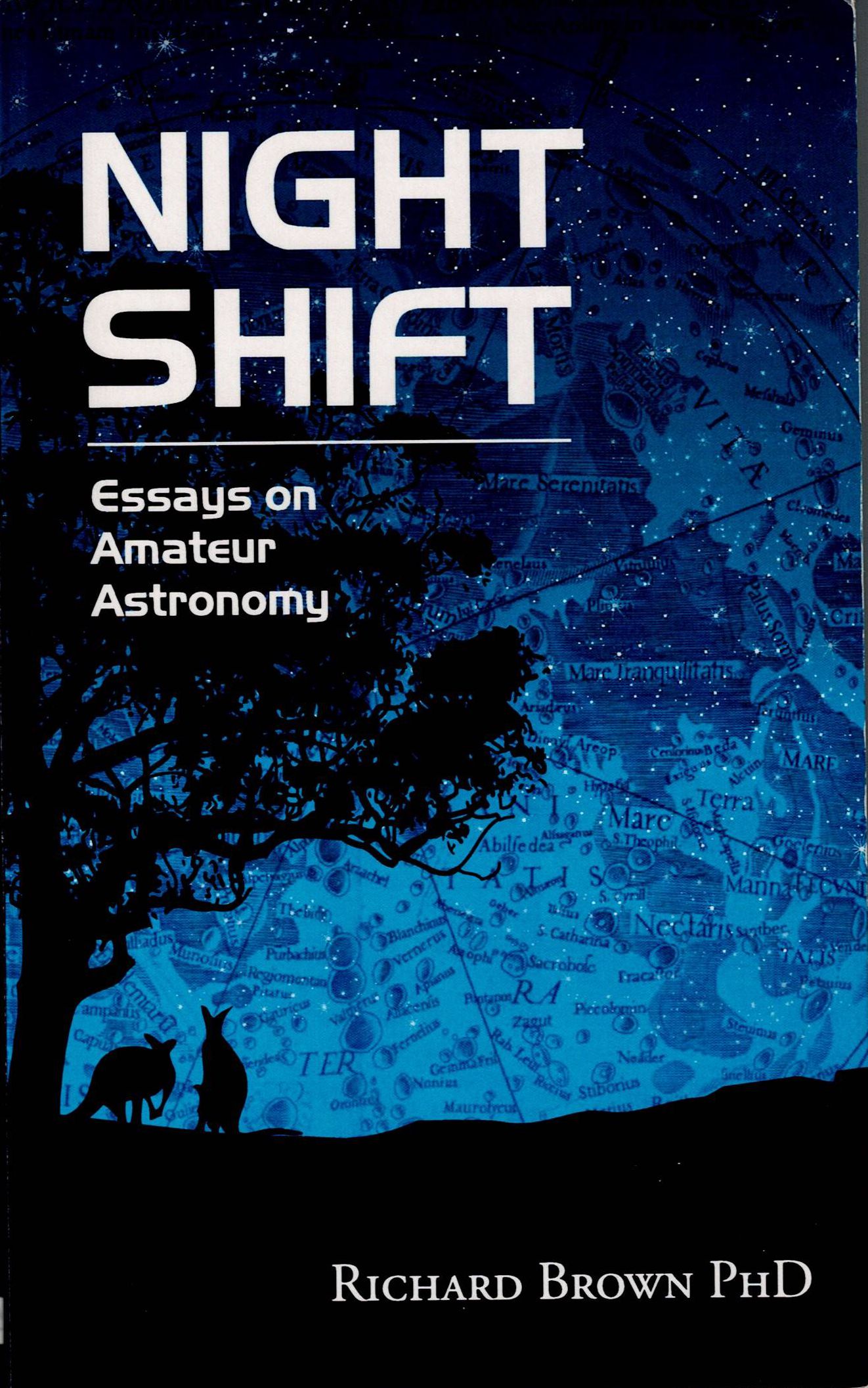
Richard Brown, PhD, 2015 “Night Shift: Essays on Amateur Astronomy”
I have received a book entitled “Night Shift: Essays on Amateur Astronomy”
from Richard Brown, PhD
seven years ago. My kids and I have stayed his house in 2009 as we have
exchanged emails before that.

Josetsu, Catching a Catfish with a Gourd (Hyonen-zu), 15th Century.
Taizo-in Temple, Kyoto.
https://commons.wikimedia.org/w/index.php?curid=377876
We got back to my mother’s house in Shiga Prefecture, we dropped in at
Taizo-in, Zen Buddhist Temple, Kyoto. There is an ink painting (national
treasure) “Catching a Catfish with a Gourd” painted in the 15th Century by
Josetsu. I remembered Richard Brown’s book to see the painting that I knew
many years ago. In his book there is a description on comet hunting as
follow.
The point is summed up nicely by an anecdote related to me by Shigeki
Murakami and passed onto him by one of the Japanese comet masters. It is
this:
“When you are hunting for comets, do not hunt for comets.”
How very elegantly Japanese, how very Zen and how very true.
What I said to him was advice by Minoru Honda for those who aspire comet
searching; “If you think you don't need to find it, go ahead (with the
comet search).” However, I did not regard it as Zen and Japanese, and I
found the way he saw it refreshing.
Getting back to “Catching a Catfish with a Gourd” painted in the 15th
Century that represents a Zen koan (a question for meditation) about how
to catch a catfish with a gourd. It is a difficult question to answer and
it is impossible to catch a catfish using a gourd. Nonetheless, the
answers by 31 Zen priests were written in the original painting.
https://www.kyohaku.go.jp/eng/learn/home/dictio/kaiga/fushigi/
As a result, there is no correct answer, and each individual must struggle
to find an answer that he or she believes right.
How do you discover a new comet using a telescope?
The answer is to keep searching, but specifically, how? This question is
too simple to call as “koan”, but even so, it is difficult to answer.
Again, each person tries to find a satisfactorily answer. Catching a
Catfish with a Gourd reminded me the same hold true.
Saturday, July 30
It has been cloudy and rainy in July and I went on a comet hunting
only once on Friday, 1 July.
On Sunday, 10 July, the 50th Annual Comet Conference was held online. The
conference has been cancelled two consecutive years due to COVID, and
finally, the 50th anniversary conference has been had. There were over 90
attendees with success.
Web site in Japanese language http://comet-conf-jp.net/046-050/050.html
The Chair of Scientific Organizing Committee has changed from Prof.
Junichi Watanabe, NAOJ, to Prof. Hideyo Kawakita, Kyoto Sangyo Univ., and
hosted by Kyoto Sangyo Univ.
Many lectures and research presentations were made following very
impressive video message by Tsutomu Seki, age 91.
They were a very full and rich program: a series of three lectures of
“Comet Observation using Digital Camera” by Mitsunori Tsumura, Ken Harikae
and Nobuyuki Nishida; “Recent Trends in the Comet World” by Hirohisa Sato;
Keynote lecture “Rosetta Probe Reveals Comet” by Dr. Hitomi Kobayashi;
research program including four oral and two poster presentations; four
Subsection Meetings.
I have chaired Subsection Meeting on Comet Hunting. There was more than a
dozen of attendees but I was the only visual comet hunter. In my
experience there were a few visual hunters besides me. I don't know if
this is a sign of the times or a coincidence.
In the subsection meeting I gave a short presentation before the
discussion began. As shown in the figure, merely five comets were
discovered in 2005 and later. Nonetheless, one or more comets visually
discoverable appeared every year on average.
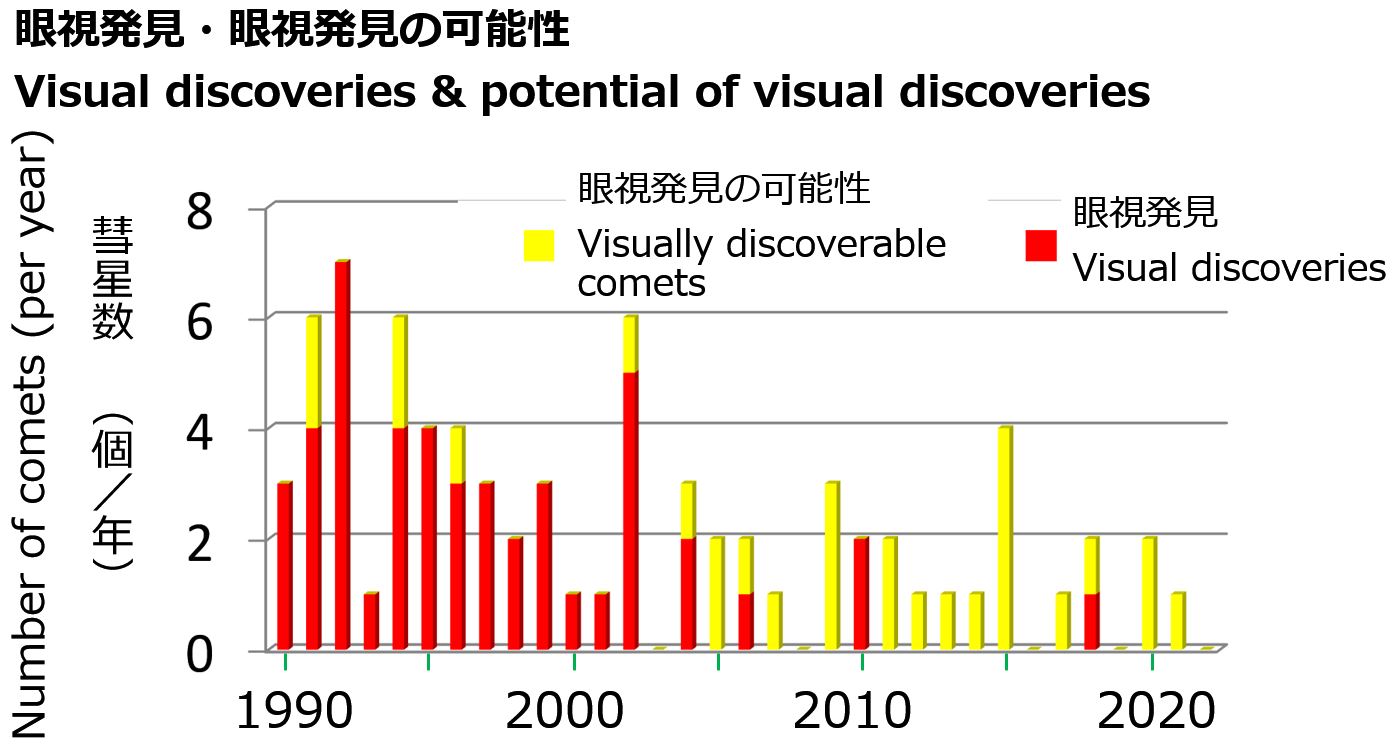
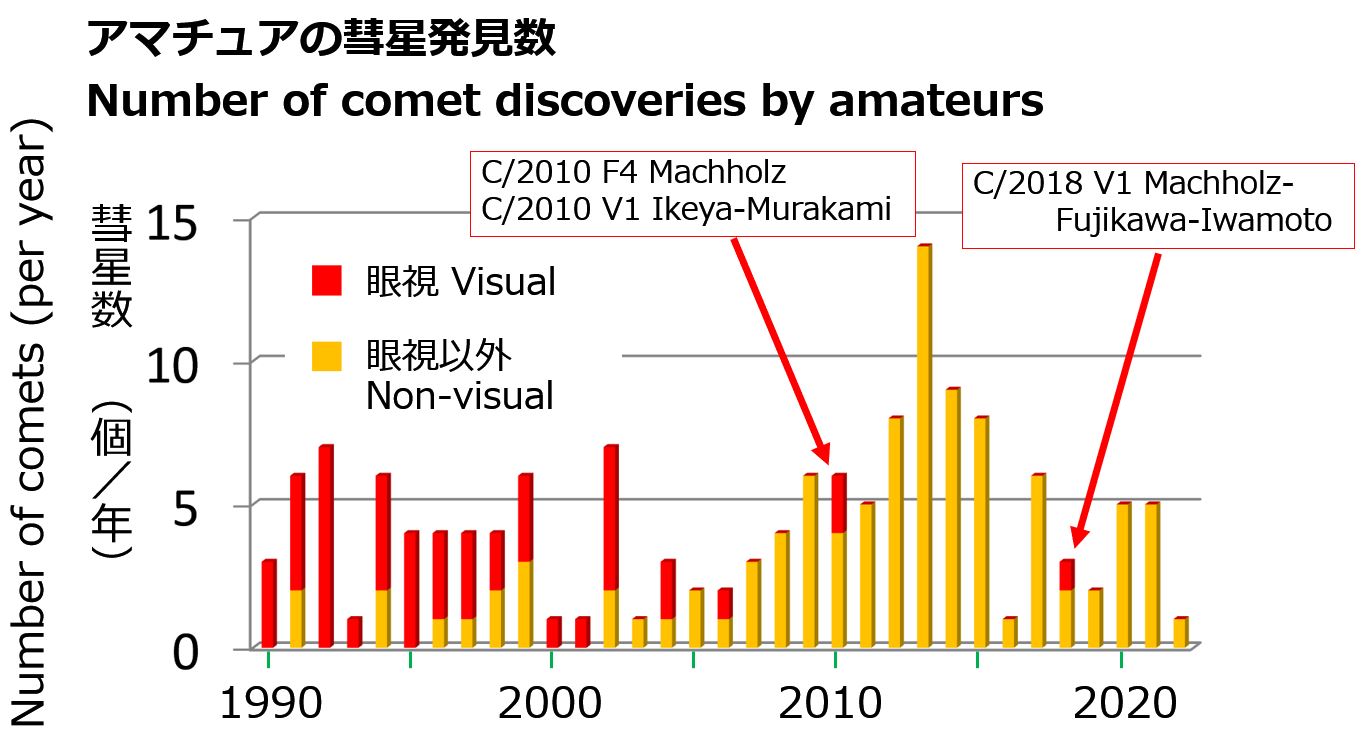
Original data Maik Meyer http://www.comethunter.de/index.html
Hideo Nishimura, a discoverer of C/1994 N1 Nakamura-Nishimura- Machholz
(visual) and C/2021 O1 Nishimura (photograph), said “The excitement when I
met a new comet visually was much higher than that of photographic
discovery.” The lower figure indicates the course of the number of comet
discoveries by amateurs. The number reached record high in 2012 to 2015.
It is because rise in discovery by amateurs using robotic survey.
I do not have an impression that amateurs detected a lot of comets in 2012
to 2015, and so do many astronomers. The way I see it, in addition to most
comets discovered by robotic surveys are dark, for both discoverers and
observers the impression of comets detected by robotic surveys is much
lower than that by photography not to mention visually.
In the Annual Comet Conference, no visual comet hunter attended. I think
the number of visual hunters declines worldwide. I understand it means the
chance of visual discovery is on the rise. It motivates me to keep
searching.
Friday, June 3 and Saturday, June 4
Friday
Some one month has been passed since I conducted the comet hunting session
last. I wanted to observe a comet, because I have not observed any comets
since February. I trained my telescope at C/2017 K2 Pan-STARRS that was
much brighter than in February: magnitude of 9.5, diameter 4’, DC=5 and
the tail length of 1’ with Night Vison. It is a typical image of comet and
I felt nostalgic.
I started the session with M2, but I did not encounter any deed sky
objects for 40 minutes. Finally, after 47 minutes after the beginning of
the session, I identified NGC7606, a 10th magnitude galaxy in the
constellation of Aquarius. Then, NGC7727, also a 10th magnitude galaxy,
was in the field of view. Additionally, three galaxies NGC7576 (magnitude
of 12.9), 7585 (11.5) and 7592 (13.5) were seen in the same field of view.
I noticed NGC7592 as it was displayed in SkySafari 6 Pro when I confirmed
NGC7576 and 7585. These five galaxies were all the deep sky objects I
observed during the session. I did not spot other galaxies that were
darker or more diffused due to poor transparency.
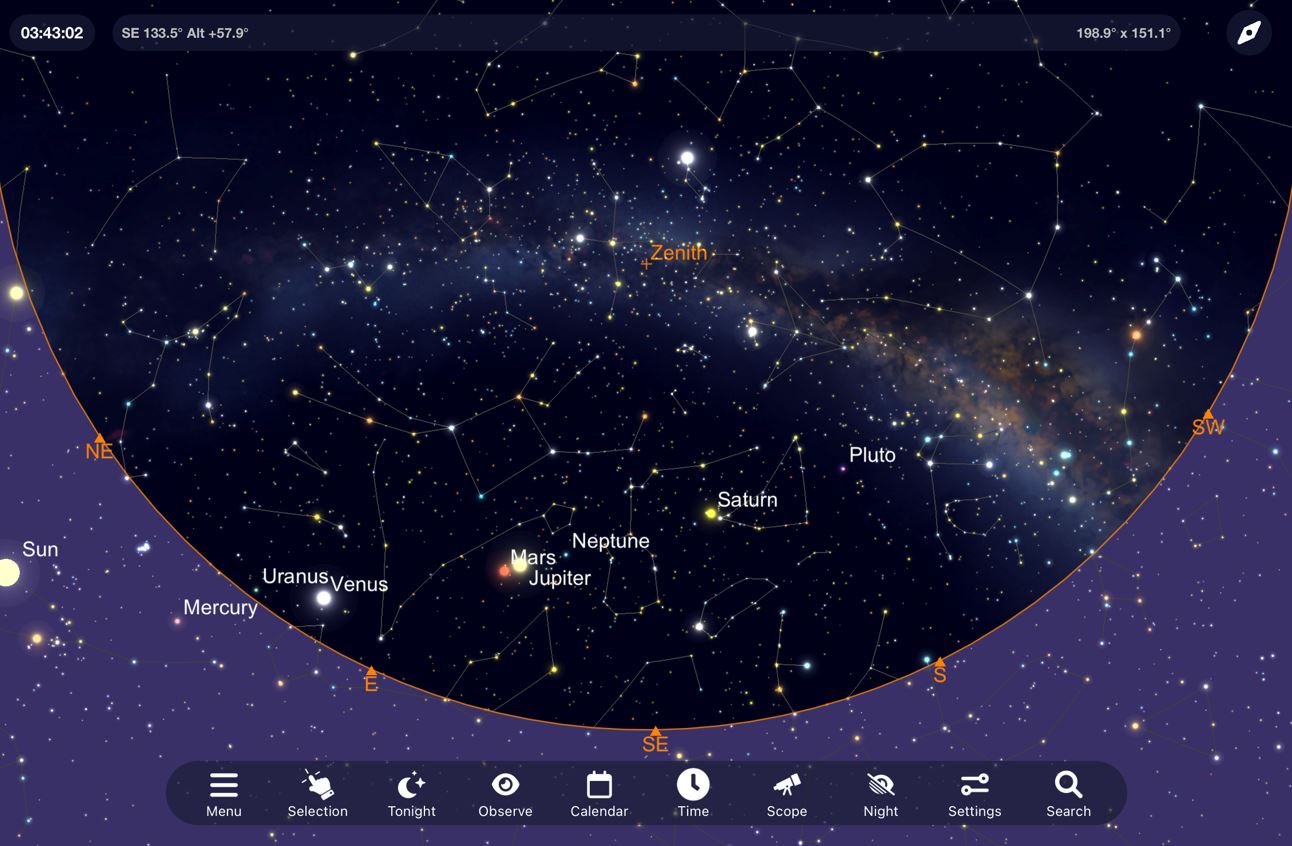
The sky 15 minutes after the start of twilight. From right to left Saturn,
Jupiter, Mars and Venus. SkySsafari 6 Pro.
At the beginning of the twilight, Venus rose above the horizon, and
Saturn, Jupiter and Mars were on the line along the ecliptic. The Milky
Way arced high in the sky. I felt the difference in the scale between the
solar system and that of our galaxy by combining vision and knowledge in
my mind. What a splendid experience! Getting back to home I have learned
that NGC7592 is 340 million light year and receding 2.4% of light speed. I
experienced the depth of our universe that may be a privilege of a comet
hunter.
Saturday
I began sweeping with NGC7585, a galaxy that I confirmed the day before.
At the beginning transparency was superior than that of yesterday, but
gradually, thin cloud started to cover the east-southeastern sky and I
changed the search area from ESE to NE.

NGC404 also known as Mirach’s Ghost.
The Digitized Sky Survey copyright © 1994
I spotted a nebula-like object right next to a bright star. I wondered it
was ghost caused by the star, but it turned out to be NGC404 named
Miacha’s Ghost. The bright star was Micha, β Andromedae.
I cannot remember that I have ever identified this object during the comet
searching session. I think the object was visible thanks to the power of
Night Vison. After a while M32, 31 and 110 came into the field of view.
The structure of M110 could be recognized that was the first experience.
This fact was another evidence of the powerful performance of Night Vison.
The last deep sky object that I spotted was NGC1060, the 12th magnitude
galaxy with an altitude of 12º above the horizon 15minutes after the start
of the twilight.
Sunday, May 29
It has been poor weather in May, and I swept the sky only once. On top
of that, the comet hunting session was unsatisfactory, because of bad
transparency of the sky.
Until four years ago I lived in Niigata Prefecture, and I was allowed to
use workshop at my workplace where I build my telescopes. However,
modifications of telescopes were halted after I came Kumamoto as there was
no workshop at work. Finally, I began to build a workshop at home this
month. Specifically, I made a workbench this month and purchased a
bandsaw. The workbench has yet painted and I have a plan to do using Old
Wood Wax (Clear).

Unpainted workbench. The size is 60cm x 120 cm.

Bandsaw and a can of Old Wood Wax on the machine table. The laminated wood
plate used for the bottom plate of the bandsaw was painted with Old Wood
Wax, but the top board of the table made of the same material was not.
Note that the bottom plate looks darker color.

From upper left: code reel, impact driver, sander, and jigsaw in front.
I plan to make another workbench with the half size of the present one to
install a tabletop drilling machine and a vise to it, which I am planning
to buy.
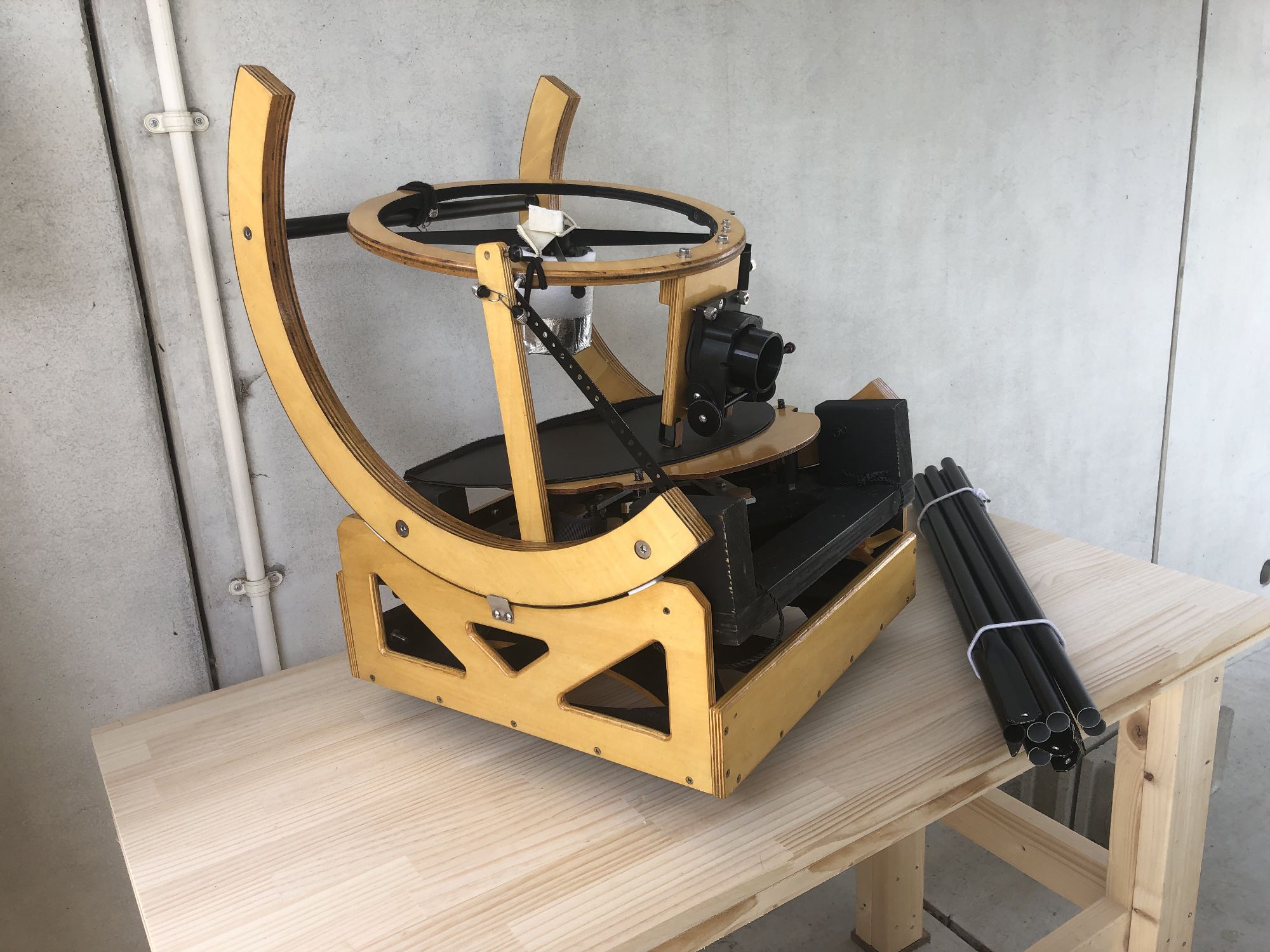
Thirty centimeters F5 Dobsonian.
Although I have a 30 cm F5 Dobsonian that is mobile and easty-to-use, it
is unusable at present due to aging of the focuser that is made of
plastic. I am planning to reconstruct the secondary cage including renewal
of the focuser to make it easier to use. The optical system is 24x, 1.7°
combining Lavendura 63 mm eyepiece and Night Vision, which enables to
enjoy deep sky objects and comet hunting at home where moderately light
polluted. In addition to that, the telescope is suitable for planetary
observation thanks to high precision of the primary mirror. I am looking
forward to renew my scope.
Saturday, April 30
I conducted comet hunting sessions five times at predawn from Monday,
April 4 through Sunday, April 10 this month. After then, I could not do
that at all due to moonlight and nasty weather. I describe sessions on
Monday, April 4 and Sunday, April 10, both of them were impressive among
the five of them.
Monday, April 4
On my way to the observing site, I encountered rabbits, raccoon dogs, and
what appeared to be marten. I have ever seen foxes, herds of deer, cattle
in the pasture, and sometimes pheasants at dawn.
The site was windless and clear sky with the air temperature of 4°C. I
began searching from M22 and before long M17 was in the field of view. I
used to overlooked M16 during the sweeping with NV. However, the nebula
was clearly seen with NV today. Application of Hα filter revealed
the faint part of the nebula that looked the same with well-detailed
photos. In my experience, when M16 was not visible with NV, the object was
not seen with the combination of NV and Hα filter either. The reason why
M16 was sometimes difficult to observe with NV was not clear; I wonder if
it is due to the low altitude or poor transparency of the atmosphere.
The next object I identified was what seemed to be diffuse nebula located
near the open cluster NGC6604. I could not confirm the object on the
display of my tablet in a digital map, SkySsafari 6 Pro, but I did paper
based map, Uranometoria 2000. The nebula turned out to be the diffuse
nebula, Sh2-54 (Sharpless2-54) extended around NGC6604, and the nebula was
impossible to observe using a conventional grass eyepiece. With the
combination of NV and Hα filter the object size was some 2°. Sh2-54 did
not appear on the display in SkySafari 6 Pro, but it was shown only when I
searched "Sh2-54" with the app.

NGC6604 (upper left) and NGC604.
By ESO - http://www.eso.org/public/images/eso1218a/,
CC BY 4.0,
https://commons.wikimedia.org/w/index.php?curid=19230541
The following deep sky object I observed was a 11th magnitude globular
cluster, Palomar 8, which is not in NGC Catalog. I confirmed M55 at 3:51am
local time at the altitude of as low as 11°, and M75 at 4:24am. I
completed the session at 5:00am.
Sunday, April 10
A dozen of people from fire brigade gathered in the parking lot on the way
to the observation site. Additionally, some members of the brigade were
walking another parking lot near the site. I wondered what happened.
I started the comet hunting session with NGC7331 that I observed in the
previous session. The altitude of NGC7331 was 13°, and I noticed Stephan's
Quintet if I looked consciously. Then, I identified 12th magnitude
open cluster in the constellation of Cygnus, NGC7044 and the Pelican
Nebula, IC5067-5070. The nebula is impossible to observe visually, but NV
made it possible. This was the first time I confirm this object during
comet hunting session. The North America Nebula was out of the searching
area.
During the session a few fire engines of the brigade went through the road
facing the observing site. After that a car parked at the site and a
couple of men approached me. I said I was gazing stars and one of them
replied they were police. I asked them what's up. They answered it was
wildfire over there. The fire was on the way to being extinguished but
they said if it extended near the site let them know.
They seemed that they wanted to look through my telescope. I told them
that I was sorry but I did not want to change the position of the
telescope and was unable to show you any objects.
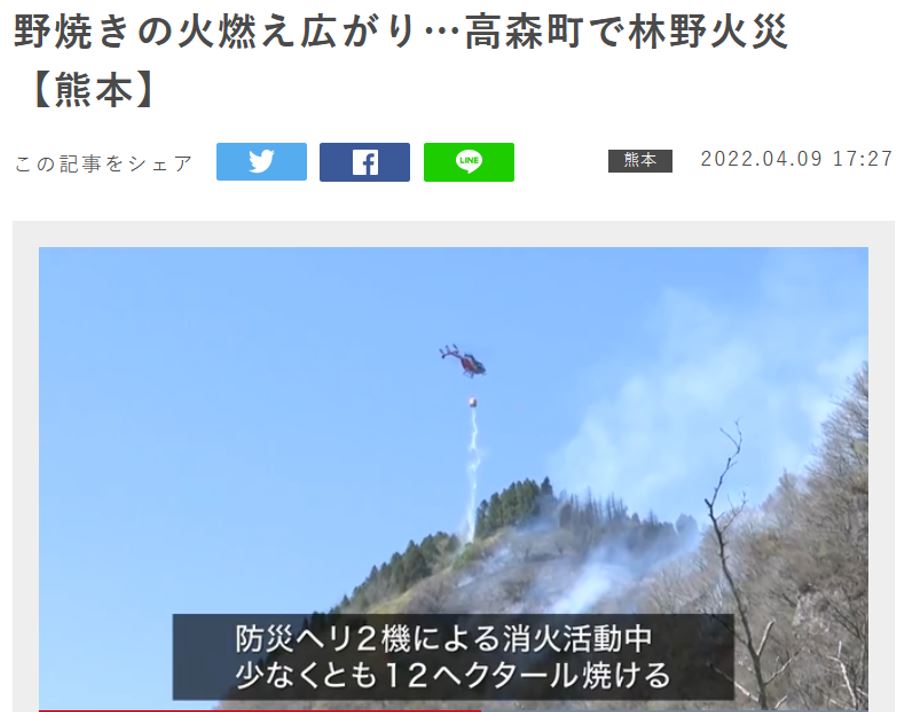
Wildfire extinguish activity. Kumamoto Kenmin TV
https://www.kkt.jp/index.html
I observed M32, M31 and M110 at the altitude of 8° at 4:24am, and finished
the sweeping at 4:57am, 30minutes after the start of the twilight.
Thursday, March 10
This was the fifth hunting session in March, and I conducted it three
consecutive days. I began the session with M4, a globular cluster in the
constellation of Scorpius, at 4:00am local time using Night Vision.
Globular clusters, M80, NGC6144, 6256 and 6388 appeared in the FOV. Most
of them that came into the FOV resolved into individual stars comfortably.
The next object I observed was not a globular cluster. It was a planetary
nebula, NGC6302, called Butterfly Nebula or Bug Nebula. The bug-like shape
was boosted using Hα filter that could apply with ease using a filter
slider. Next, M62 entered the FOV and shining wonderfully.
Oh, maybe… Without doubt I was observing NGC6334, Cat's
Paw Nebula. It was the first time that I saw the object that exactly
looked the photo of it with Hα filter as I observed before.
Identifying additional two globular clusters, NGC6235 and M19, I
noticed Lobster Nebula, NGC6357, without the filter. This object also
looked the same shape as the photo through the filter.
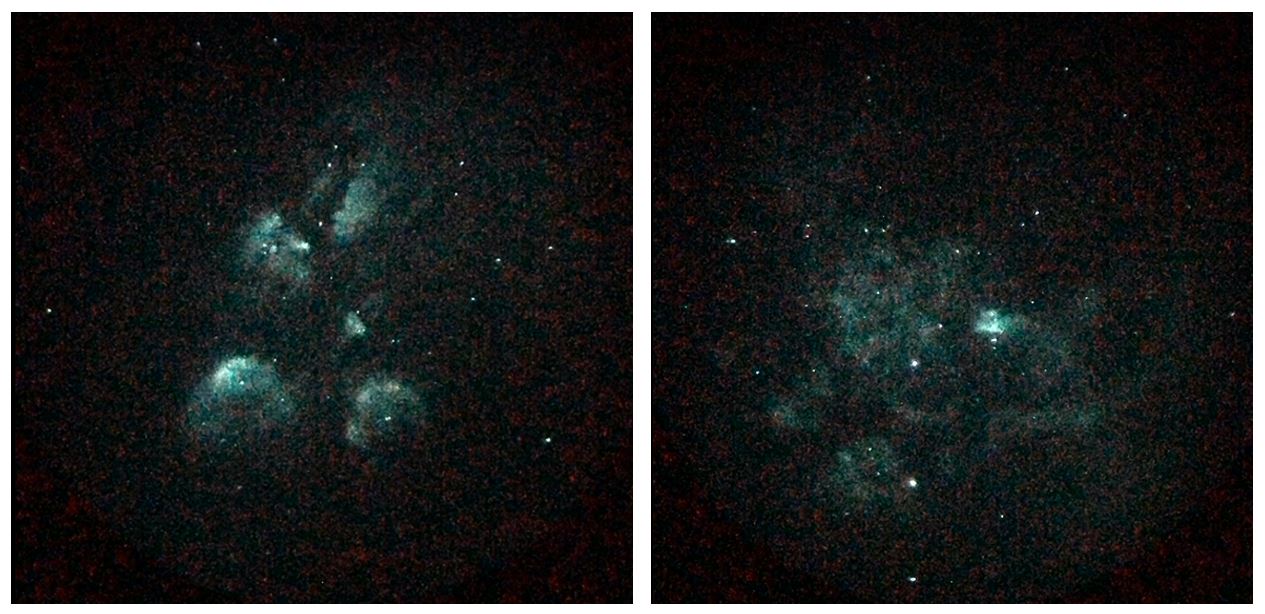
Left: Cat's Paw nebula, NGC6334; Right: Lobster Nebula, NGC6357.
46 cm, 37x Hα filter, iPhoneX. Photo by author on Aug. 13 2020 JST.
Left: Cat's Paw nebula, NGC6334; Right: Lobster Nebula,
NGC6357. The image is 60' wide.
The Digitized Sky Survey copyright © 1994
Oh, maybe… Without doubt I was observing NGC6334, Cat's
Paw Nebula. It was the first time that I saw the object that exactly
looked the photo of it with Hα filter as I observed before.
Identifying additional two globular clusters, NGC6235 and M19, I
noticed Lobster Nebula, NGC6357, without the filter. This object
also looked the same shape as the photo through the filter.
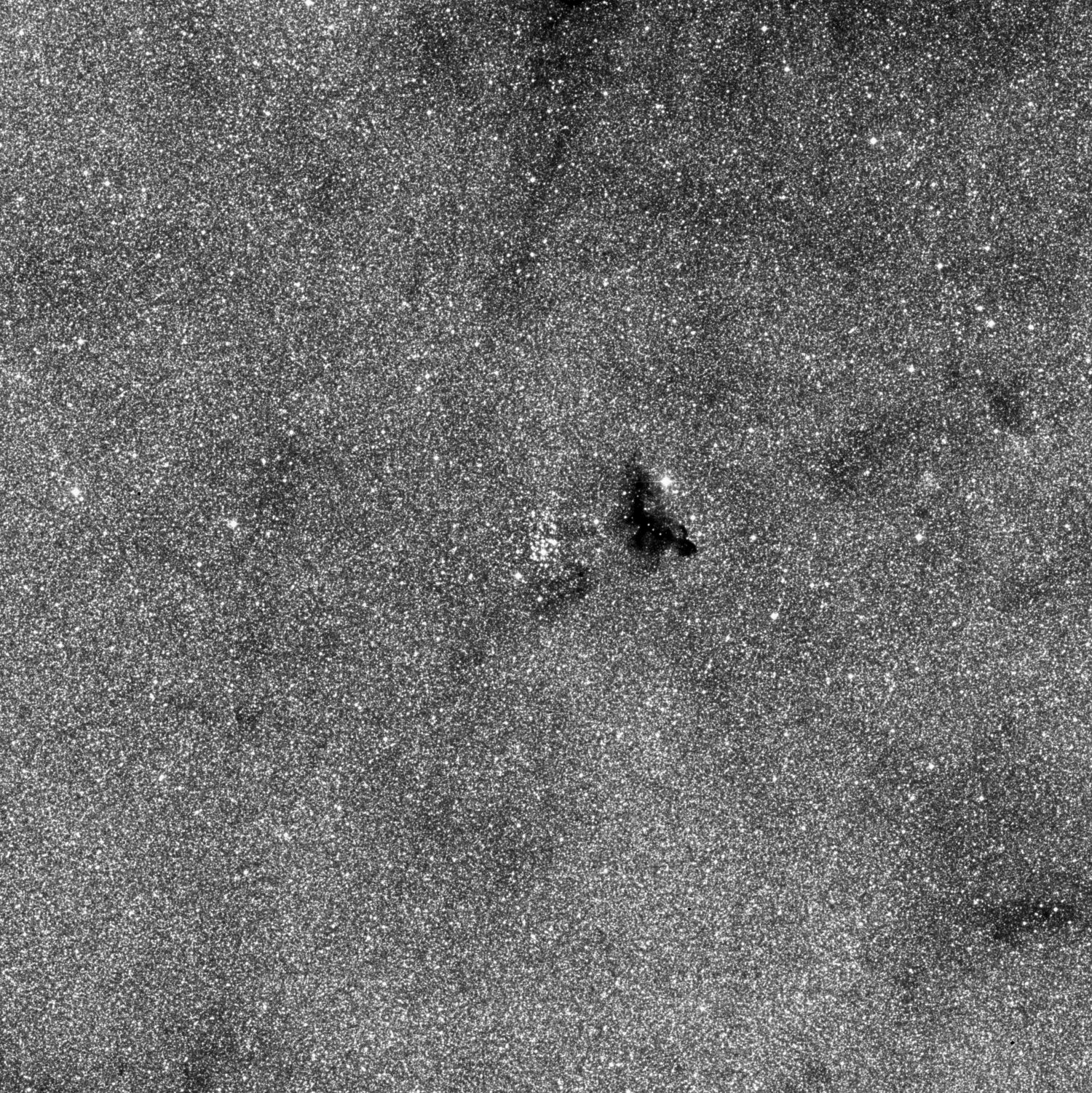
Barnard 86, dark nebula, and NGC6520, open cluster. The position and the
shape of Djorg 2 is not clear in the photo. The image is 60' wide.
The Digitized Sky Survey copyright © 1994
I remembered that I have ever identified a small globular cluster named
Terzan 5 with the magnitude of 13.85. As for the magnitude, another source
said it has the magnitude of 12.8 and I opine that seems to be correct. https://en.wikipedia.org/wiki/Terzan_5
The myriad stars of the Milky Way and the intricate dark nebulae are
wonderful.
One cannot see as many stars with a glass eyepiece. A dark nebula, Barnard
86 that has a gaping hole, a brilliant open cluster, NGC6520 right next to
Barnard 86. SkySafari 7 Pro indicates a globular cluster Djorg 2 in the
FOV. The official name is Djorgovski 2 with the magnitude of 9.89 and the
diameter of 9.9'.
I looked hard and spotted the object, but the diameter seemed smaller than
0.5'. The small diameter explains the reason why I could not identify it
until now. Night Vision enables me to continue searching some 30 minutes
after the start of the twilight. I have finished comet hunting session 32
minutes from the beginning of the twilight when M28, a globular cluster in
Sagittarius, came into the FOV. I was really impressed by dark nebulae and
some objects that I have spotted for the first time during the comet
hunting session.
Friday, February 9, National Holiday
We have had many nasty weathers at the middle of January and after,
due to cold wave. This is the second comet hunting session in February.
I had a plan to get up at 3am, but I woke up just past 2am. I could not
see any stars at my house, but the forecast predicted clear sky at my
observing site at 3am. I left anyway and arrived at the observing site at
3:09am that was earlier than the original plan. Wonderful starry sky
welcomed me there. I observed some deep sky objects before the hunting
session using Ethos 21 mm 97x and Night Vison 37x.
Omega Centauri was an easy target with naked eyes. Although it was
magnificent that the field of view was filled with quite a few of stars
with Ethos 21 mm, each individual star looked dark due to low altitude of
the object. Application of NV enhanced the brightness of the stars that
made the cluster more splendid. I enjoyed looking at some galaxies: M65,
66, NGC3628, M101, 51 and 106 using both Ethos 21 mm and NV. I cannot make
general comments on which eyepiece was better because both of them had
pros and cons. The faint part of the spiral arms in M101 and M51 looked
better using Ethos 21 mm with an averted vision. While the galaxies looked
better unless I did not apply averted visions.
C/2017 K2 PanSTARRS was difficult to observe regardless of the eyepiece,
i.e., Ethos 21 mm and NV, although the altitude was 18º that was not very
low. I think it was challenging to spot this 12th magnitude comet. When I
saw the comet on Wednesday, February 2, the appearance was the same
independent of the eyepiece. Contrary, this time the comet looked defused
with Ethos 21 mm, while the apparent diameter was smaller and only the
central part of it could be seen using NV.
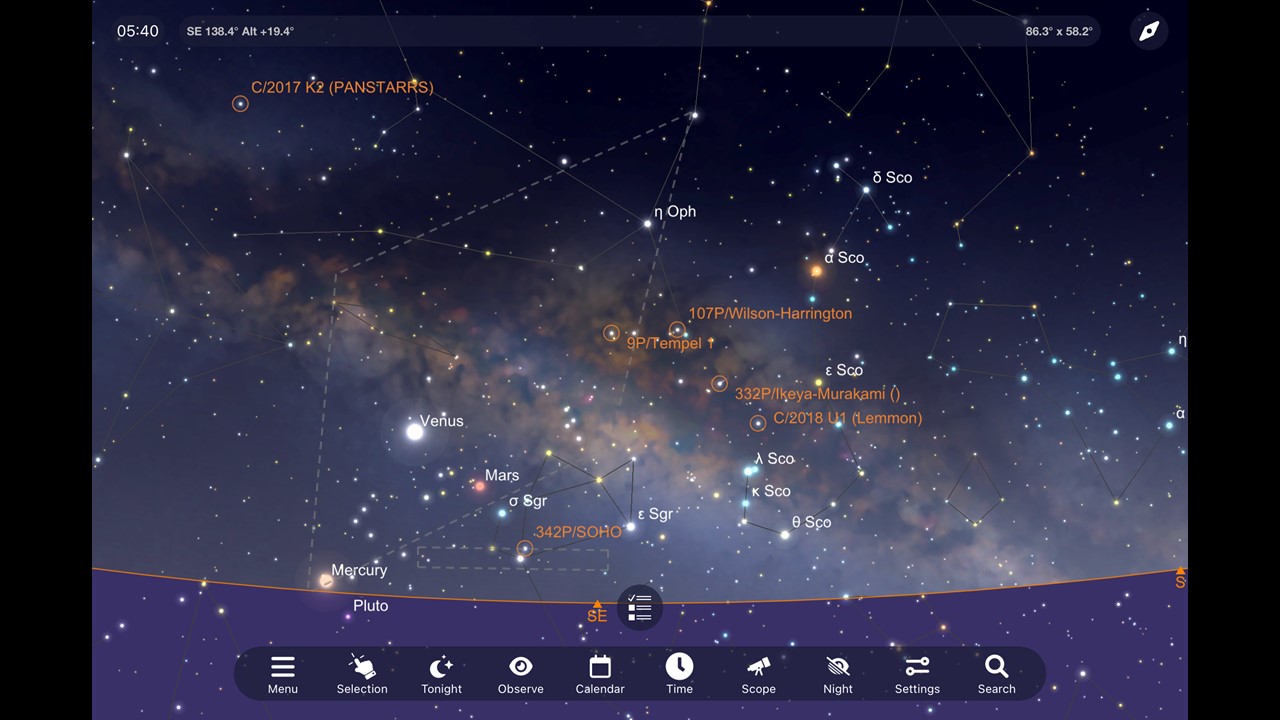
Click to enlarge
The southeastern sky at the time of the beginning of the twilight
displayed by SkySafari Pro 7. At the slightly right of the center 332P
Ikeya-Murakami is shown but the comet had not been recovered at the last
return in 2021.
The Milky Way rose above the eastern horizon that can be mistaken as a
cloud. I started comet hunting from M9 that is located at the "water
front" using NV. The search areas are shown in the figure above as a
diamond shaped and rectangular (lower center) with broken lines. I swept
the rectangular area in several minutes just before the end of the
session.
I have often experienced the ultimate pinpoint star image with NV, because
it yields low magnification and has sensitivity for infrared area that is
less susceptible to seeing. In some globular clusters, you can see stars
so tightly packed together that you think, "There can't be a smaller dot".
M14 is a typical example of the case.

M14. The image is 60' wide.
The Digitized Sky Survey copyright © 1994
The Milky Way in the constellation of Scutum is another sight beyond
description that the field of view is filled with stars of pinpoint.
Scutum reminded me of the "discovery" in February in 2004.
http://comet.la.coocan.jp/discovery/Unconfirmed/Unconfirmed_comet.html
After my report no one could confirmed the object and it became a phantom
comet.
At the last session air temperature was as low as -6ºC, but this time the
air was milder with the temperature of -3ºC. The weather was not very
severe and I could really enjoy the star field.
Saturday, January 8
The comet world was enlivened by the brightening of C/2021 A1 Leonard
at the end of last year. I went observing the comet to Mifune town,
Kumamoto, and I describe the detail of the sketch drawn using my 46 cm
reflector. Besides the comet observation, I went to comet hunting four
times since the beginning of this year.
Friday, December 31
A star friend of mine had already set up his telescope when I arrived at a
observing site just after 5pm. We had a small talk, and I myself set up my
46 cm and 20 cm reflectors. The objective of the 46 cm and the 20 cm
scopes were, respectively, observing near the comet nucleus and the tail.
The sunset was 5:23pm, and I could not spot the comet even at 6pm. After
additional 10 minutes or so, I could find the comet using the 20 cm 38x
with Ethos 21 mm in the actual field of view of 2.6°. The tail appeared as
time went, and the length was some 3° with the 20 cm 38x. The tail length
observed using the 46 cm was a bit shorter than that seen by the 20 cm
scope. The length seen by Night Vision (NV) was shorter than that observed
by Ethos 21 mm, i.e., around 2° using the 46 cm telescope.
I could not see any structure near the nucleus of the comet by the
combination of telescopes (the 46 cm and the 20 cm) and glass eyepieces
(Ethos 21 mm and Ethos 13 mm). The structure was not seen using the 20 cm
with NV either, but I observed clear structure as shown in the sketch with
the combination of the 46 cm and NV.

Near the nucleus region of C/2021 A1 Leonard. Right: December 31 18:30 JST
(UT+9h) 46 cm 37x, Night Vison PVS-14. Only near the nucleus region was
sketched. Left: Photo of C/2021 A1 taken by Mr. Keisuke Sakata almost the
same time as the sketch. Courtesy of Mr. Keisuke Sakata, a star friend of
mine.
The nucleus of the comet looked crushed and elongated, and the jets were
ejected from the nucleus that formed the envelopes. The southern side of
the tail, upper part of the sketch, looked like a straight, crisply cut
shape. When I raised and lowered the gain of NV, the faint and bright
parts of the comet were visible and hidden. I drew the sketch by
compositing those images in my brain. Thanks to NV I could enjoyed an
interesting feature of the comet.
You can see clearly that the right part of the nucleus is bright on the
enlarged photo taken by Mr. Sakata (lower right of the photo). I did not
notice the distribution of the brightness in the nucleus visually.
I observed the existence of the comet and the tail using 7x50 mm
binocular. I failed to see the comet with naked eyes this time, although I
saw them when the comet was in the predawn sky.
I felt the air was very chilly and looked at the thermometer that had
dropped to -4°C.
Top of this page















